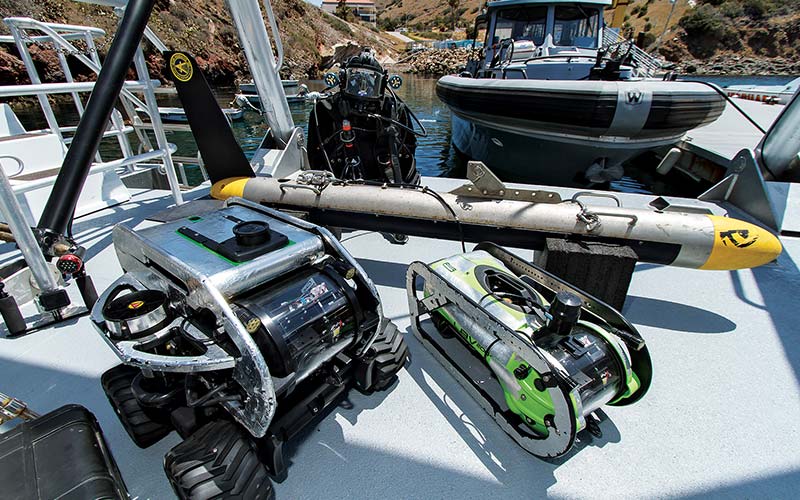The large hangar visible from the water has become a comforting sight for the divers who visit the southern part of California’s Channel Islands. In operation for almost 40 years, the University of Southern California (USC) Catalina Hyperbaric Chamber is available to treat injured divers 24 hours a day, 365 days a year. It is a unique facility in many ways. Not only does it serve recreational and technical divers in the waters around Catalina Island, it also serves an active scientific diving program based out of the USC Wrigley Marine Science Center, where the chamber is housed.
While there are approximately 1,200 hyperbaric chambers throughout the United States, fewer than 140 are available 24 hours a day, and the Catalina chamber is one of only two that are dedicated solely to divers. The chamber is run by an almost all-volunteer crew, which is supported by medical staff from the Los Angeles County Fire Department and the emergency department at Los Angeles County/USC Medical Center.

In most places when a suspected decompression injury occurs, the diver is taken to the closest emergency department for evaluation and then transferred to a hyperbaric facility if needed. The Catalina chamber’s capabilities and unique position in the midst of some of the most popular diving in Southern California, however, means divers around Catalina Island are transported directly to the USC Wrigley Marine Lab. Some arrive via Baywatch boats from the Los Angeles County Fire Department, but many are brought in by the area’s dive charter boats.
Chamber staff and the paramedics of LA County Fire evaluate the divers and consult with the attending physicians and residents of the emergency department at Los Angeles County/USC Medical Center. The chamber itself is considered an extension of that emergency department. If needed, the orders for recompression treatment are given and an emergency physician is brought to the island to evaluate and oversee the treatment.
A look through the cabinets in the hangar reveals many of the supplies, medications and equipment one would expect to see in a dedicated trauma room at a major hospital. The chamber is equipped to evaluate and treat everything from ear injuries to cardiac arrest. Stable divers as well as those in critical condition can be treated in the chamber. Following treatments, divers who require hospitalization travel with the emergency physician back to Los Angeles to receive continued evaluation and treatment.

Generally speaking, a hyperbaric facility could not stay in business if it was available only for diving emergencies. Daily treatments for wounds that aren’t healing are the mainstay of hyperbaric medicine. The Catalina Hyperbaric Chamber needs additional sources of revenue since it only treats scuba divers. Partial funding comes through a contract with Los Angeles County, and the Los Angeles County/USC Medical Center bills for treatments. That contract and billing for treatments, however, are not sufficient to allow the chamber to maintain 24-hour availability. In fact, 25 years ago the chamber’s funding was at risk, and the possibility of closure loomed.
Each year since then the chamber has held Chamber Day on the first Wednesday in May. Dive boats from around the Los Angeles area donate their proceeds that day and use their boats to bring divers and other interested members of the public to the marine lab for a tour of the facility. Baywatch paramedics from Los Angeles County Fire Department, Los Angeles County Sheriff’s Department marine and aviation divisions and the United States Coast Guard are also on hand to meet the public. Chamber Day Evening takes place at the Aquarium of the Pacific in Long Beach, where a banquet and silent auction is held.
While the chamber also earns income through educational programs, research and other private donations besides those made on Chamber Day, as much as 50 percent of the facility’s annual revenue comes in each year on Chamber Day. Part of what makes the day so special and successful is the dedication that is evident among the staff. Each year a new theme and logo for Chamber Day are created, and many divers return every year for the festivities.
For more information about the history and mission of the USC Catalina Hyperbaric Chamber, visit dornsife.usc.edu/hyperbaric.
© Alert Diver — Q3 Summer 2013